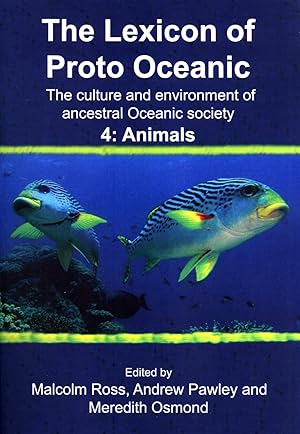Malcolm Ross; Andrew Pawley; Meredith Osmond Editors (1 results)
Product Type
- All Product Types
- Books (1)
- Magazines & Periodicals
- Comics
- Sheet Music
- Art, Prints & Posters
- Photographs
- Maps
-
Manuscripts &
Paper Collectibles
Condition
- All Conditions
- New
- Used
Binding
- All Bindings
- Hardcover
- Softcover
Collectible Attributes
- First Edition
- Signed
- Dust Jacket
- Seller-Supplied Images
- Not Printed On Demand
Seller Location
Seller Rating
-
The Lexicon of Proto Oceanic: The Culture and Environment of Ancestral Oceanic Society. 4: Animals (Pacific Linguistics, 621)
Published by Australian National University, 2011
ISBN 10: 0858836262ISBN 13: 9780858836266
Seller: Masalai Press, Oakland, CA, U.S.A.
Book
Soft cover. Condition: Very Good. 576 pp., illustrations, maps, bibliography, index. This is the fourth in a series of seven volumes on the lexicon of Proto Oceanic, the ancestor of the Oceanic branch of the Austronesian language family. Each volume deals with a particular domain of culture and/or environment and consists of a collection of essays each of which presents and comments on lexical reconstructions of a particular semantic field within that domain. Volume 4 examines the terms that Proto Oceanic speakers used to name animals and parts of animals. After the general introduction to the series, Chapter 2 presents more than 140 POc reconstructed names for fish, as well as many additional names attributable to major interstages below POc. Chapter 3 investigates the retention rates of a sample of 52 POc fish names and asks why the number of fish names reconstructed for POc is so much smaller than the number typically distinguished by contemporary Oceanic languages. Chapter 4 presents reconstructions of terms for aquatic invertebrates. Chapter 5 deals with terms for mammals, reptiles and amphibians. Again it is partly about creatures of the sea. Other than New Guinea, the islands of Oceania have few native land mammals. Chapter 6 deals with names for bird taxa and other terms associated with birds. Chapter 7 is entitled 'Insects and other creepy-crawlies', the latter including non-insect terrestrial invertebrates: spiders, centipedes, worms, leeches and grubs. The final chapter of the volume, chapter 8, investigates the semantic histories of several terms that may have been high-level generics or life-forms in the POc taxonomy of animals. It looks for recurrent patterns in the way different languages have extended or reduced the referential range of each of these terms. 0.0.


